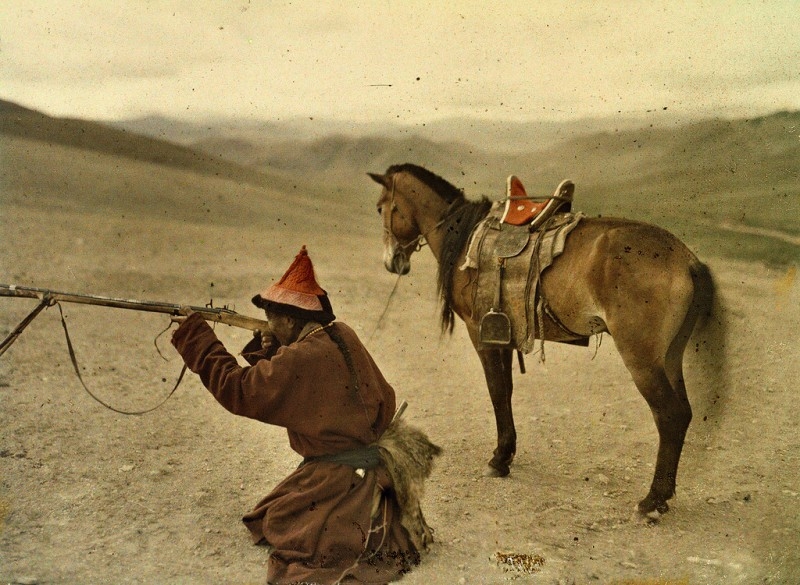In 1909, Kahn traveled with his chauffeur and photographer, Alfred Dutertre to the Far East on business and returned with many photographs of the journey. This prompted him to begin a project collecting a photographic record of the entire Earth. He appointed Jean Brunhes as the project director and sent photographers to every continent to record images of the planet using the first color photography, autochrome plates, and early cinematography. Between 1909 and 1931 they collected 72,000 color photographs. The landlocked country of Mongolia, which gave the world Genghis Khan and had the largest contiguous empire in history, was reduced to a subject of China’s Qing Dynasty by the 17th century. Being a nomadic Buddhist country, by the early 20th century, almost a third of the male population of Mongolia consisted of monks. Mongolia at the start of the 20th century was agrarian, and its people were highly stratified socially and economically. There were two classes of vassals: the khamjlaga, who under Manchu law were serfs for life of the local nobility and civil administrators; and the shavi, the vassals of the monastery estates. Trade in essentials like tea, rice, and tobacco was in the hands of Chinese companies, which willingly extended credit at high interest rates. The currency consisted of units of livestock, as well as tea bricks, small silver ingots, and some foreign coins. When the officials and nobility got into debt, they would increase their taxes in kind on the population. As a result, many Mongols were impoverished and occasionally rebellious, despite the risk of terrible punishment at the hands of the Qing authorities, who had built fortified administrative centers and garrison towns like Khovd and Uliastai to control Mongolia’s regions. By 1911, when the Chinese Revolution broke out, unrest was widespread in Mongolia. In December the Manchu amban was ordered to leave, the Javzandamba was proclaimed the Bogd Khan (“Holy King”), and he declared the independence of Mongolia—Inner Mongolia and Tannu Tuva, as well as Outer Mongolia. Also at that time, the Bogd Khan’s capital, Ikh Khüree (“Great Monastery”), was renamed Niislel Khüree (“Capital Monastery”). The Qing emperor abdicated in 1912, and the Republic of China was proclaimed. Also that year Russia signed a treaty with the Bogd Khan’s government that recognized Mongolia, although the interpretation of this recognition between the two parties differed: Mongolia considered itself independent of China, while Russia characterized Mongolia as being “autonomous.” The Russian position was further underlined in 1913, when Russia and China issued a declaration stating that Mongolia was still under Chinese suzerainty. Mongolia objected, but this status was reinforced by a joint Russian-Chinese-Mongolian treaty in 1915, in which the Bogd Khan’s government was obliged to accept autonomy under Chinese suzerainty. As a result, the Bogd Khan was unable to unite the Inner with Outer Mongolia, nor was he able to prevent Russia from colonizing Tuva. Soviet power was established in St. Petersburg following the Russian Revolution of 1917, and it gradually was extended eastward across Russia. In August 1919 the Soviet Russian government recognized Mongolian autonomy, but within a few months Chinese troops had occupied Niislel Khüree and deposed the Bogd Khan. During that turbulent period, Mongolian nationalists Dansrangiin Dogsom, Dogsomyn Bodoo, and others formed underground resistance groups and established contact with Russian Bolsheviks. Meanwhile, tsarist cavalry units under the command of Baron Roman von Ungern-Sternberg (known as the “Mad Baron”) entered Mongolia from eastern Siberia, advanced on Niislel Khüree, drove out the Chinese occupation forces, and in February 1921 restored the Bogd Khan to the throne under the baron’s control. The rule of the Mad Baron was cruel and bloody but relatively brief. In March 1921 the Mongolian revolutionaries gathered in Troitskosavsk, where they adopted a program of action and appointed a provisional cabinet. A Mongolian revolutionary force was assembled under Sükhbaatar’s command that, along with Soviet army units, advanced southward into Mongolia and in July 1921 captured Niislel Khüree. A “people’s government” of Mongolia was appointed, with Bodoo as prime minister, and July 11 subsequently was celebrated as the anniversary of its establishment. The Bogd Khan was reinstated as a constitutional monarch with limited powers. The baron was captured in August, handed over to the Soviet authorities, and executed. In November Danzan and Sükhbaatar were sent to Moscow to meet Lenin, and the first Mongolian-Soviet treaty was concluded. (Photo credit: Albert Kahn collection / Stefan Passe / Wikimedia Commons / Britannica). Notify me of new posts by email.
Δ Subscribe
.jpg)
.jpg)
.jpg)
.jpg)
.jpg)
.jpg)
.jpg)
.jpg)
.jpg)
.jpg)
.jpg)
.jpg)
.jpg)
.jpg)
.jpg)
.jpg)
.jpg)